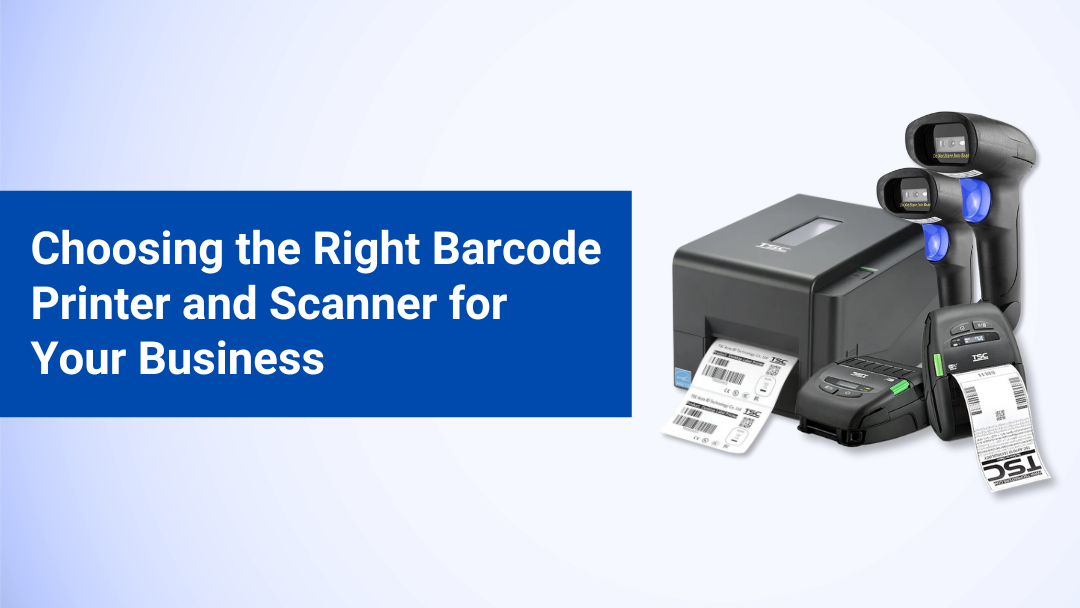Choosing the Right Barcode Printer and Scanner for Your Business
Hey Business Enthusiasts! Are you confused about getting started with barcode printers and scanners? If yes, This well-researched article is just for you. It will not only clear your doubts but will also help you make the right buying choice. To explore, scroll till the last.
What are barcode printers?
A barcode printer is a device that prints barcode labels or tags that can be attached to products, packages, or assets. These barcodes contain encoded information that can be read by barcode scanners.
Types of Barcode Printers:
- Thermal Transfer Printers: Use heat to transfer ink from a ribbon onto a label. The printed barcodes are durable and suitable for long-term use, such as product labeling, asset tracking, and inventory management.
- Direct Thermal Printers: Use heat-sensitive labels that darken when heated by the printhead. These labels don’t require ink, toner, or ribbon, making the process simpler and cheaper. However, the labels are less durable and can fade over time, making them ideal for short-term applications like shipping labels.
Key Features:
- Resolution (DPI): Determines the clarity and quality of the printed barcode. Higher DPI is needed for smaller or more detailed barcodes.
- Print Speed: The speed at which the printer can produce labels, typically measured in inches per second (IPS).
- Media Compatibility: The range of label materials and sizes the printer can handle, from paper to synthetic labels.
What are barcode scanners?
A barcode scanner is a device that reads barcodes and converts them into readable information, usually by connecting to a computer, point-of-sale (POS) system, or other devices.
Types of Barcode Scanners:
- Laser Scanners: Use a laser beam to read 1D barcodes (traditional linear barcodes). They are fast and effective for long-range scanning and are commonly used in retail environments.
- Image-based (Imager) Scanners: Capture an image of the barcode using a camera. These scanners can read both 1D and 2D barcodes (like QR codes) and are more versatile, often used in environments requiring scanning of damaged or poorly printed barcodes.
- CCD (Charge Coupled Device) Scanners: Use an array of tiny light sensors to capture the barcode image, similar to a camera. They are durable and can read barcodes at a short distance.
Key Features:
- Connectivity: Scanners can be wired (typically USB) or wireless (Bluetooth or Wi-Fi). Wireless scanners offer more flexibility in movement but may require charging.
- Durability: Some scanners are designed to withstand harsh environments, with features like drop resistance and water resistance.
- Scan Range: Determines how far the scanner can be from the barcode while still accurately reading it.
Applications:
- Retail: Barcode scanners are used at checkout counters to quickly and accurately ring up items. Barcode printers are used to generate price tags and labels.
- Warehousing and Logistics: Barcode printers generate labels for inventory management and shipping, while scanners track items as they move through the supply chain.
- Healthcare: Barcodes are used for patient identification, medication tracking, and lab samples, with scanners ensuring accuracy in handling these items.
- Manufacturing: Barcodes help in tracking parts and products throughout the production process, from raw materials to finished goods.
Why are barcode scanners and printers important for a business?
Barcode scanners and printers play a crucial role in business growth by streamlining operations, improving accuracy, and enhancing productivity. Here’s a brief on why they are crucial for a business-
1) Improved Efficiency and Speed:
- Quick Data Entry: Barcode scanners allow for instant data capture, significantly speeding up processes like checkout, inventory management, and order processing. This efficiency reduces waiting times for customers and accelerates operational workflows.
- Automated Labeling: Barcode printers enable businesses to produce labels on demand, eliminating the need for manual labeling. This automation reduces errors and ensures that items are labeled correctly and consistently.
2) Enhanced Accuracy:
- Reduction in Human Errors: Manual data entry is prone to mistakes, which can lead to costly errors in pricing, inventory counts, and order fulfillment. Barcode scanners virtually eliminate these errors by automating the data entry process.
- Accurate Inventory Management: With barcode technology, businesses can maintain precise inventory levels, reducing the chances of stockouts or overstocking. Sustaining customer satisfaction and improving supply chain management depend heavily on this accuracy.
3) Cost Savings:
- Lower Labor Costs: By automating data entry and inventory management tasks, barcode scanners and printers reduce the need for manual labor, allowing businesses to allocate resources more efficiently and reduce labor costs.
- Reduced Inventory Losses: Accurate tracking of inventory through barcodes minimizes losses due to theft, misplacement, or spoilage, leading to significant cost savings.
4) Better Decision-Making:
- Real-Time Data Access: Barcode systems provide real-time visibility into inventory levels, sales data, and product movement. This information enables businesses to make informed decisions, such as when to reorder stock or which products to promote.
- Data Analytics: With accurate data captured by barcode scanners, businesses can perform in-depth analysis of sales trends, inventory turnover, and other key metrics. These insights can guide strategic decisions that drive growth.
5) Scalability:
- Supporting Business Growth: As businesses expand, barcode systems can easily scale to accommodate increased volumes of products, transactions, and locations. This scalability ensures that operations remain efficient even as the business grows.
- Integration with Other Systems: Barcode scanners and printers can integrate with various business systems, such as POS, ERP (Enterprise Resource Planning), and CRM (Customer Relationship Management) platforms. This facilitates business growth and permits expansion with ease.
6) Enhanced Customer Experience:
- Faster Checkout Process: In retail settings, barcode scanners speed up the checkout process, leading to shorter lines and a better overall shopping experience. This increases client loyalty and satisfaction.
- Accurate Order Fulfillment: In e-commerce and logistics, barcode technology ensures that orders are picked, packed, and shipped accurately. This accuracy reduces the likelihood of returns and increases customer trust.
7) Compliance and Traceability:
- Regulatory Compliance: Many industries, such as healthcare, food and beverage, and pharmaceuticals, require strict adherence to labeling and traceability standards. Barcode printers and scanners help businesses comply with these regulations, avoiding legal issues and penalties.
- Product Traceability: Barcodes enable businesses to track products throughout the supply chain, from manufacturing to delivery. This traceability is essential for quality control, recalls, and customer transparency.
8) Improved Security:
- Asset Tracking: Businesses can use barcode technology to track assets such as equipment, tools, and vehicles, reducing the risk of theft or loss. This tracking also helps in asset maintenance and management.
- Access Control: Barcodes can be used in employee ID badges and access control systems, enhancing security within the workplace by ensuring that only authorized personnel have access to certain areas.
How to pick the right barcode printer and scanner?
Choosing the right barcode printer and scanner for your business involves considering several key factors to ensure that the devices meet your specific needs. Here’s all that you should consider.
1) Identify Your Business Needs:
- Volume of Printing/Scanning: Consider how many barcodes you’ll need to print and scan daily. High-volume operations may require industrial-grade printers and scanners.
- Type of Barcodes: Determine whether you need to work with 1D or 2D barcodes. 2D barcodes (like QR codes) require scanners that can read more complex patterns.
- Environment: The environment in which the devices will be used can impact your choice. For example, warehouses may need rugged, durable printers and scanners that can withstand dust, moisture, and rough handling.
2) Choosing a Barcode Printer:
- Printing Technology: There are two main types of barcode printers: Thermal Transfer Printers: These use a ribbon to transfer ink onto labels. They produce durable, long-lasting labels suitable for product labeling and inventory management. Direct Thermal Printers: These do not use a ribbon but instead use heat-sensitive labels. They are ideal for short-term labeling needs, such as shipping labels.
- Print Resolution: Higher DPI (dots per inch) provides better quality printing, which is essential for small or detailed barcodes.
- Print Speed: If you need to produce a large number of labels quickly, consider a printer with a high print speed (measured in inches per second).
- Label Size and Media Compatibility: Ensure the printer supports the label sizes you need and can handle the type of media (paper, synthetic labels) you plan to use.
3) Choosing a Barcode Scanner:
- Type of Scanner: Laser Scanners: Ideal for 1D barcodes; they are generally faster and more accurate for reading linear barcodes. Image-based Scanners: Can read both 1D and 2D barcodes and are often more versatile. These scanners capture an image of the barcode, making them more effective in low-light conditions or on damaged codes.
- Connectivity: Choose between wired or wireless scanners depending on your mobility needs within your workspace. Wireless scanners offer flexibility but may require regular charging.
- Scan Range: Consider the distance from which the scanner needs to read barcodes. Long-range scanners are useful in large warehouses or retail spaces.
- Durability: If the scanner will be used in a rugged environment, look for models that are drop-resistant and water-resistant.
4) Integration and Compatibility:
- Software Compatibility: Ensure the printer and scanner are compatible with your existing point-of-sale (POS) system, inventory management software, or any other relevant systems.
- Ease of Integration: Look for devices that can easily integrate with your current hardware setup (e.g., plug-and-play USB connections) and software (e.g., drivers, SDKs for custom integration).
5) Budget Considerations:
- Initial Cost vs. Long-term Value: While it’s important to stay within budget, consider the total cost of ownership, including maintenance, consumables (like labels and ribbons), and potential downtime.
- Brand and Warranty: Reputable brands often offer better customer support, longer warranties, and more reliable products, which can save money in the long run.
6) Test Before You Buy:
- Demo Units: Test the barcode printers and scanners in your actual work environment to ensure they meet your performance expectations.
- Feedback from Users: Consult with employees who will use the devices daily to ensure the chosen models are user-friendly and efficient.
7) Consider Future Growth:
- Scalability: Choose devices that can handle increased demand as your business grows, without needing to be replaced soon after purchase.
SUMMING UP
Selecting the right barcode printer and scanner requires a balance of functionality, durability, compatibility, and cost. By carefully considering your specific business needs and testing potential options, you can ensure that your investment will improve your operations’ efficiency and accuracy.

